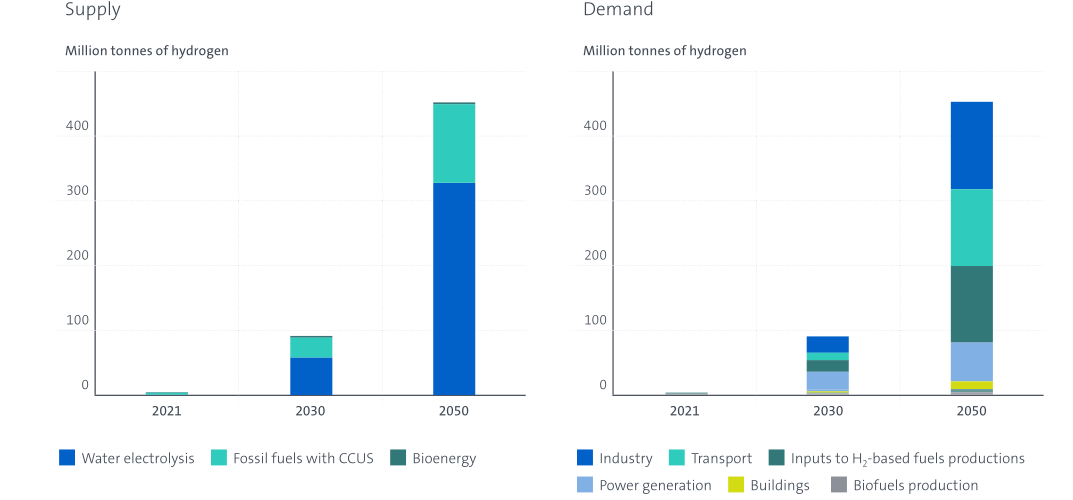Hydrogen: the future of clean energy

Why hydrogen?
As a potential and widely used energy carrier, the rapid change of hydrogen's opportunities is largely related to three new considerations of energy planners, which are not related to the basic technology of hydrogen:
1. All countries and enterprises focus on eliminating, not just reducing, the impact of fossil fuel emissions on their energy systems. This goal is often referred to as "net zero emissions", focusing on how to avoid fossil fuel emissions in all sectors, including those with the greatest comparative advantage of fossil fuels, such as heavy industry and long-distance transportation (IEA, 2021). Among the few alternatives in these fields, hydrogen and other combustible fuels that can be made from it have the most attractive characteristics in terms of energy density, storability and chemical properties.
2. The net zero commitment of most countries and enterprises has set 2050 as the target year, which is consistent with climate science. In less than 30 years, the complete reform of energy systems, transportation systems, building stocks and industrial processes requires rapid mobilization of large amounts of capital, including infrastructure. The urgency of time demand gives hydrogen an advantage because it can connect new assets with existing infrastructure, such as the transportation and storage of natural gas and oil.
3. Finally, the speed of improvement in cost and performance of wind energy, solar energy and batteries forced energy planners to change their consensus. In 2021, wind energy, solar energy and battery investment accounted for 40% of the global power industry investment, more than three times the scale of fossil fuel power generation investment (IEA, 2022a). Now there is a broad expectation that the safest and most competitive energy system in the future will be guided by variable renewable electricity, which poses the challenge of how to provide electricity to as many energy users in an affordable way. Using electricity to produce hydrogen from water is one of the most effective ways to store electricity for a long time, so it can be used in places where electricity is difficult to reach, or for purposes that do not match the time of renewable energy generation.
In short, hydrogen is not an energy source, but an energy carrier, which means that its potential role is similar to that of electricity. The report of the International Energy Agency, "The Future of Hydrogen", introduces various ways of converting different energy sources into hydrogen, different ways of hydrogen storage and distribution, and different applications of hydrogen (International Energy Agency, 2019). Like electricity, hydrogen has the advantage that it can flexibly perform various energy-related tasks, provide multiple energy inputs, and have no carbon dioxide emissions when used. If the interconnection between electricity and hydrogen value chain is properly planned, this flexibility may enhance the overall security of the energy network.
Increase the supply and demand of low-emission hydrogen
Although it is possible to produce hydrogen from a series of energy inputs, not all ways can reduce (greenhouse gas) emissions. In 2021, the world produced about 94 million tons of hydrogen, whose energy content is equivalent to 2.5% of the global final energy consumption. Less than 1% are produced using low emission production technology (IEA, 2022b). The hydrogen is mainly used in two industries: oil refining and chemical production (including ammonia for fertilizer). In order to make a valuable contribution to the energy transformation, both the supply side and the demand side need to change.
1. In terms of supply, only low-emission hydrogen can be compatible with the decarbonization of the energy system. Low-emission hydrogen can be produced from water from renewable energy or nuclear power generation, from processing fossil fuels in facilities equipped to avoid carbon dioxide emissions (for example, through CCUS with high capture rate), and from relevant facilities with the lowest methane emissions, or from bioenergy. Although some of these solutions have been deployed, others are still in the early stage of development. All these solutions need to be further developed and expanded to ensure full cost competitiveness.
2. In terms of demand, in addition to chemical and oil refining, hydrogen needs to penetrate into more industries. Most of these new applications are "energy" applications, such as transportation, high-temperature heating and the manufacture of alternative fuels (so-called low-emission hydrogen-based fuels, such as ammonia or synthetic kerosene) for ships and aviation as energy inputs. New non-energy applications include replacing coal and natural gas as reducing agents in steel production. As with hydrogen supply, these applications usually involve the implementation of new technologies, many of which have not been verified on a large scale. The demand of each sector will depend on the advantages of these hydrogen-based options compared with other decarbonization solutions.
In short, the government's actions in both supply and demand are increasing. A total of 26 governments have adopted national hydrogen strategies, including 9 adopted since September 2021 (IEA, 2022b). In Europe, the Russian-Uzbekistan war disrupted the supply of natural gas, and the determination of the European Union to rapidly expand renewable electricity and hydrogen has been strengthened. In May 2022, the European Commission proposed that by 2030, the EU's demand could rise to 20 million tons, which could replace the 27 billion cubic meters of natural gas demand and 4 million tons of oil demand. Considering the domestic resources of the EU in the use of renewable electricity for hydrogen production and the challenges faced by such rapid expansion, the proposal believes that half of this total amount needs to be imported from outside the EU. At present, the facilities for international hydrogen trade do not exist commercially, but considerable attention is being paid to exploring how to use the existing infrastructure, such as those for ammonia or natural gas trade, to achieve this goal.
Appendix 1: Supply and demand of low-emission hydrogen under the IEA net zero emission scenario

1) Description of English terms:
Water electrolysis: electrolytic water
Fossil fuels with CCUS
Bioenergy: bioenergy
Industry: industry
Industry: Transportation
Inputs to H2-based fuels products
Power generation
Buildings: buildings
Oil refining
Biofuels production
2) Energy description:
1Mt H2 contains energy equivalent to the average annual energy consumption of 2 million EU households. Norway's natural gas production in 2021 is equivalent to 35 million tons of hydrogen.
Appendix 2: New and total installed capacity of electrolytic cells in various regions by 2030

